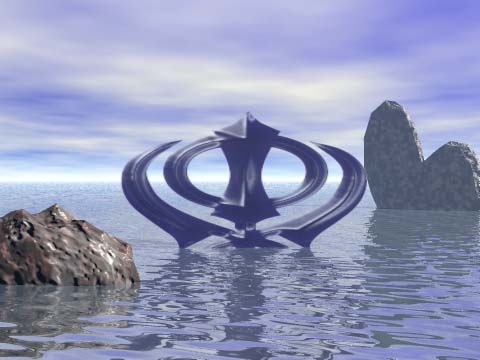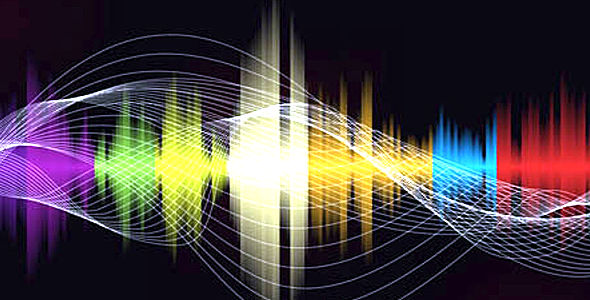FOLLOW:
Doorways in Consciousness: An Exploration of Resonant Being
 By Carlisle Bergquist
By Carlisle Bergquist
ABSTRACT
Many cultures around the globe embrace sound in their exoteric and esoteric traditions. This essay reviews the role sound plays in the religions, creation myths, and sacred technologies of various peoples. This review connects creativity with healing which is considered an act of regeneration thus creating health in the body. Several varieties of healing through sound are discussed including music, toning, chant, instruments, and prayer. The essay proposes that techniques of healing through sound currently rely on the intuitive ability of individual practitioners. Acknowledging the need for effective healing modalities, it calls for research that can qualify the elemental effects of existing sounds, tones and prayers. Such categorization may help construct an applied holistic healing technology.
INTRODUCTION
A crowd of people made their way through the narrow street and up the steps into the small Templo Guaracy. Inside they gathered around the perimeter of a low railing that surrounded an open wooden floor. At the far end of the room stood several statues with an assortment of flowers placed around them. Three drums ranging from 4 to 6 feet tall stood on one side of this altar. Three men dressed in white entered and took their positions behind each drum and, after a brief welcome by the Father of the Saints, the leader of the temple, they began to play.
In a few moments about a dozen individuals assembled on the wooden floor and begin to dance to the rhythm of the drums. The resounding Candomble cadence filled the room. Each dancer embodied the pulse and became more distinctive as the ritual progressed, their movements more idiosyncratic until a transformation occurred. Eventually, each individual fell into a trance-like state and personified a spirit evoked through their journey on the sound of the drums.
The ritual described above invoked healing spirits in an Umbanda ceremony that I attended outside Såo Paulo, Brazil. I had the chance to experience the ritual’s potency for myself later in the evening. The Father of the Saints invited me and others to enter the area before the altar and dance as the rhythm moved us. Within a short time I felt an inexplicable strong wave of force move outward from the altar as I spun around seemingly from its effect. The woman dancing directly behind me also succumbed to the presence and fell to the floor. We had watched, listened to, and felt the power of sound and its capacity to affect our consciousness.
Sound has for millennia been a locus of the search for enlightenment. From the quiescent lilt of a mountain brook, to the rhythm of a human heart, sound provides a pathway to the deep reaches of our psyche. Sound gives us access to reverie states wherein we find insight, healing, growth, and our highest creativity. Sound — vibration — grants us such passage because it accesses the core of our being. This essay will review sound and the way it is described in creation stories, the exploration of consciousness, and healing. The scientific community, until recently, has given little attention to the effects of sound on our consciousness. The medical applications of sound are acknowledged but tend to focus on diagnostic and discrete treatment procedures. This essay deals with consciousness and thus the information reviewed is mostly from psycho-spiritual and esoteric writings.
SOUND AS CREATOR
Physicists, attempting to determine the precise nature of…matter, have probed deeper into the realms of atomic and subatomic behavior, only to find that there is…no ‘thing’ there in the sense in which we normally think of matter. They describe the tiniest subatomic particles as ‘interference patterns of various sound frequencies.’ They call them ‘nodes of resonance.’ (Carey, 1992, p. xi)
Before the advances in modern physics, many myths in some way implicated sound as causal in creation. Sound in many of them, as Carey suggests above, precedes manifestation of all forms and energy. The creation stories that begin the western traditions of Judaism, Islam, and Christianity imply an “a priori” movement. The Babylonianís religion spoke of a third aspect of creation that existed between heaven and earth: “a third element they called lil — a word which the nearest meaning would be wind, air, breath, or spirit; its essential characteristics seem to have been…movement and expansion” (Doresse, 1986, p. 268)
Exoteric Traditions
Judeo-Christian Cosmology
His image is the word, a form more brilliant than fire; — the Logos is the vehicle by which God acts on the universe, and may compare to the speech of man. (Philo, trans. 1914, Pike)
The philosopher Philo spans the years when Christianity diverged from Judaism. His translation (text unknown) of “the word” implies vibration — movement — sound as the root of creation. Neil Douglas-Klotz (1990) points out that the Hebrew, Arabic, and Aramaic languages all express many layers of meaning with one word. The same word may be translated as name, light, sound, or experience. Thus “His image” is movement.
In the beginning was the Word, and the Word was with God, and the Word was God. The same was in the beginning with God. All things were made by him; and without him was not any thing made that was made. In him was life ; and the life was the light of men. (John 1: 1-4, King James Version)
Logos [Greek] as interpreted in the Wisdom or Sophia tradition has a receptive female implication. This translation from the Greek Judeo-Christian texts suggests first, that a willfully directed energy, brought some-thing out of no-thing; and second, that the receptive, empty quality, was with it at the beginning. This union again suggests movement in the oscillation between the two poles of the projective creative father and receptive mother of form. Thus, both the translations of the Word as sound and the oscillation between the projective and receptive in creation delineate vibration.
The rich mystical tradition of the Eastern Orthodox Church also reflects this view. The creator God works through the auspices of the Logos in the writings of St. Maximos the Confessor’s Four Hundred Texts on Love as follows. “God is the Creator from all eternity, and he creates when He wills, in His infinite goodness, through His coessential Logos and Spirit.” (The Philokalia 2, Palmer, Sherrard, & Ware, Trans. 1981, p. 100)
The Jewish tradition also describes the second translation that I associate with oscillation in the Book of Proverbs. The passage links wisdom and the creative spirit. Wisdom, is translated from the Aramaic word Hokmah. It represents a feminine, receptive principle.
The Lord created me at the beginning of His course, as the first of his works of old. In the distant past I [wisdom] was fashioned, at the beginning, at the origin of earth. There was still no deep when I was brought forth, No rich spring water. (Proverbs, 8: 22-24; Jewish Publication Society)
I was with Him as a confidant, a source of delight every day, Rejoicing before Him at all times, Rejoicing in His inhabited world, Finding delight with mankind. (Proverbs 8: 30-31)
The Jewish mystical tradition — as revealed in the Kabballa — further extends the role of sound in creation. I have included that material in the section of this essay on esoteric traditions.
Sufi Cosmology
The Sufi sect of Islam attaches considerable significance to sound, starting with the abstract sound called saut-e sarmad. According to Sufi Master Hazrat Inayat Khan (1983) this is the sound referred to in the Qurían with the words “Be! and all became” (Al- Qurían, 2: 117). Kahn also suggests that this is the sound heard by many spiritual figures in moments of revelation. Mohammed heard it in the cave of Ghar-e Hira when lost in the divine ideal; Moses on Mount Sinai communing with God; Christ during prayer and fasting in the wilderness; and Shiva who heard the anahad nada during samadhi in the Himalayas.
Man is not only formed of vibrations, but he lives and moves in them; they surround him as the fish is surrounded by water, and he contains them within him as the tank contains the water. His different moods, inclinations, affairs, successes and failures, and all conditions of life depend upon a certain activity of vibration, whether these be thoughts, emotions, or feelings. (Khan, 1983, p. 5)
The Sufis say the abstract sound is the source of knowledge for all masters and the ground of being from which all form manifests. However, beyond this abstract sound is the creative sound hu that is held most sacred. Muslims call it ism-e Azam, or the name of the Most High. They consider it the origin and the end of every sound and the background of each word. They say every animal, bell, and gong utter hu; thus all creation continually cries out the name of the Most High.
Hindu Cosmology
Om! –This syllable is this whole world.
Its further explanation is: —
The past, the present, the future — everything is just the word Om.
And whatever else that transcends threefold time — that, too, is just the word Om. (Mandukya Upanisad)
Nada Brahma — sound, the creator God. India is rich with creation myths from its long spiritual and philosophical history. India has spawned many religions and sects: most consider “Om” the generative creative sound that encompasses all. It is Om-nipresent. “Sound or vibration works through the various levels of density from Brahma to audible sound and becomes the basis of matter” (Judith, 1987, p. 270). The Chandogya Upanishad, cited below, chronicles this manifestation process.
The essence of things here is the earth. The essence of the earth is water. The essence of water is plants. The essence of plants is a person (purusa). The essence of a person is speech. The essence of speech is the Rg (hymn). The essence of the Rg is the Saman (chant). The essence of the Saman is the Udgitha (loud singing)…..
The Rg is speech. The Saman is breath. The Udgitha is the syllable “Om.” (Chandogya Upanishad)
Eastern traditions also espouse a relationship between creation and vibration. The story of Purusa in the Rg Veda correlates to the creation of heaven and earth. The Vedas say the God Purusa divided into a thousand parts, and embraced all (Radhakrishnan & Moore, 1957). By logical extension, in a universe formed from sound, Purusa divided must exist as millions of frequencies in eternal resonance.
Other Traditions
Sound permeates the creation stories or cosmologies of many other traditions, more than can be espoused in this writing. Thus, I will only briefly mention a few more. This is a pragmatic choice rather than intended deference to those included. The Native American Tsalagi (Cherokee) legend says, “The primary tone, the foundation of all worlds, is sung by the quartz crystal.” (Ywahoo, 1987, p. 33) Chinese Taoist stories speak of Kung, the Great Tone of Nature (Keyes, p.14). Pythagoras taught that sound was a creative force and the Mystery Schools following his teachings held music as a therapeutic tool (Keyes, p. 15; Gardner, p.132).
Esoteric Traditions
Esoteric traditions also traverse the domain of spirit. There are many. I discuss only three traditions here, separate from the above religious cosmologies, that make clear reference to sound. These are “proactive” spiritual technologies that, even though some of the traditions mentioned encompass them, differ from their more passive, exoteric counterparts.
Kabballa
When God was about to create the world by his word, the twenty-two letters of the alphabet descended from the terrible and august crown of God whereon they were engraved with a pen of flaming fire. They stood round about God, and one after another spoke and entreated, “Create the world through me.” (Haggadah, 1909/1984)
The Haggadah is an early Kabballist story. Like the Sufi tradition, the Kabballa makes extensive reference to sound. Haggadah means legend and it was passed along orally for centuries. Kabballa itself means oral tradition. The passage above shows the connection the early Kabballists make with sound and especially the formation of sound in the Hebrew alphabet and words. The Kabballa still extols the power of sound as a key influence on the human psyche.
The goal of Kabballa is to clear and align the total human being. The process of healing and repairing is not an individual goal. The mastery of Kabballa allows one to better serve humankind and the planet. The primary aim of Kabballa is tikkum olam — to repair the world. Kabballa comprises the constitution of humans with four bodies; Atzilut, the spiritual body; Beriyah, the mental body; Yetzirah, the emotional body; and Assiyah, the physical body. Each of these bodies contains the “Tree of Life” on which are 10 energy centers called Sefirot. These 40 Sefirot are a vibrant system through which the divine comes into manifestation. The individual works to empty these centers of negative influence and thus bring more Divine Light into the world. Sound is an effective means of clearing and vivifying these centers since they are themselves vibration and thus express sound.
Mark Malachi (1995) expresses an additional way the Kabballa develops vibration or sound:
Each thought creates something, for energy is not wasted. As we are taught in physics, the first law of thermodynamics states that energy cannot be created or destroyed. Therefore we must conclude that the energy of thought must go somewhere. Indeed it helps create the arrangement of particles in the physical world….Thought is vibration. It manifests itself as a wave….Since it is vibratory in nature, it has sound. (p. 166)
Thus, the Kabballistic equation adds a new vibration, that of thought. One might say metaphorically the Kabballa raises sound to the third power, or “sound(3).” Thus we have: the sound as tone effected by sound as letters effected by sound as thought or kavvanah — the power of focused intention. The degree to which one masters each of these, is the degree to which the Kabballist masters the arts of revelation and creation. Kabballa works to repair the world in co-creation with the “Most High.”
Rudolf Steiner
When man is artistically engaged with tone, he puts his ear to the very heart of nature itself; he perceives the will of nature and reproduces it in series of tones. (Steiner, 1983, p. 3)
Rudolf Steiner wrote on a broad range of subjects and throughout them he held a keen awareness of resonance. He developed Bio-Dynamics a method of enhancing plant growth by using substances that would resonate with what he perceived as the frequencies of the plants themselves. Likewise in his approach to education — The Waldorf Schools — he used tone and music as development tools. For example he believes that children should comprehend the interval of fifths in the first few years of schooling and not be introduced to thirds until around nine or ten. Steiner’s beliefs about tone and music pervaded his perspective on the nature of humankind.
Steiner proposed that the fall and evolution of an individual are revealed in their appreciation for certain intervals. Humans existed as spiritual beings in the distant past and experienced all the intervals of a scale freely. It is not entirely clear what his term ìexperienceî means but it implies something beyond the ability to hear and perceive. According to his theory, humankind lost the ability to experience the full scale with the descent into the dense physical body. In the alleged Atlantian era the primary interval was the seventh. The music of that time used this interval dominantly, which completely transported individuals into the spiritual world without awareness of their physical being. The ability to experience the fifth followed, which allowed communion with the spiritual realm but did not remove the physical awareness. Steiner proposes that in our current era the third is the interval of experience and indicates that humankind has become completely aware that their consciousness now dwells in a physical being. Steiner posited that the return path of spiritual development comes as one becomes able to experience the various intervals, foremost of which is the octave. He asserted that experiencing the octave is becoming aware of the spiritual self that is not trapped in physical form.
Steiner wrote that humans return nightly to a world of tones in their sleep. One’s consciousness during the night changes with spiritual development. First, one becomes aware of and remembers their dreams. Second, the dreams become vivid and colorful. This may be what Laberge (1985) calls lucid dreaming. Finally a change occurs in deep non-REM sleep. Steiner suggested that one is able to be conscious during the entire night. The spirits of humans go to a higher spiritual world where tones are the preeminent feature in the normally unconscious period of sleep. The spiritually developed person will remember these experiences. Steiner called this world Devachan. He said that each night human spirits are embraced by these tones whether or not one remembers it. In the process they are realigned, refreshed, healed, and inspired. Thus, in this dream world, humankind ventures near the source where, as Steiner proposed, “a tone lies at the foundation of everything in the physical world” (1983, p.106).
Alice A. Bailey
The SOUND is the sole expression of the Ineffable Name, the secret appellation of the One in Whom we live and move and have our being, and Who is known to the Great White Lodge through this name. (Bailey, 1960, p. 53)
Alice A. Bailey’s expansive writings form a complicated, and at times cryptic, system of thought. It is a cosmology, and a system of magic too vast to cover adequately within this essay. It is based on the notion that there are seven rays that, through their interaction, manifest creation. The qualities of these rays allegedly evince in all energy, matter and the various levels of human existence that she delimits. The rays are vibrant energy and have their counterpart expression in the physical world as the colors of the rainbow. They are not themselves light in the physical sense but are similar at some higher spiritual level. However, the rays themselves ostensibly unfold from sound at a still higher spiritual level. The mental world where, according to Bailey a “magician” works, also resembles this process.
The chief agency by which Nature’s wheel is moved in a phenomenal direction is sound, for the original sound or word sets in vibration the matter of which all forms are made and initiates that activity which characterizes even the atom of substance….
….First the sound and then the first effect of sound, the pouring forth of light, causing the revelation of the thought form. (1951, pp. 142 & 144)
Bailey also details an extensive model of the “constitution of man” and methods of psychological, physical and spiritual healing (1951, 1951, 1953, 1960, 1962). She proposes that Humankind has seven bodies, each of which expresses the qualities of one of the various rays. In healing and creative work, the practitioner produces an interval (two-tone chord) simultaneously. The first tone is associated with his/her soul and is sounded inaudibly on the mental plane. The second tone, to which his/her personality responds, is sounded audibly. (1951, p. 127) This practice, used with meditation and affirmation, constructs the Antahkarana, or Rainbow Bridge, that aligns the seven bodies and connects them with higher spiritual realms. Thus sound is an agent of divine creation and the agent through which the aspirant becomes a conscious co-creator.
Summary of Sound As Creator
“In the original mantric language, the name of a thing is the sound of the thing itself.” (Jill Purce, 1988, p. 23)
This section has traced the role of sound in the creation myths of various exoteric religions and peoples. It also explored sound in several esoteric traditions wherein individuals attempt the task of becoming co-creators with the ongoing work of the Divine. There are as many such myths as there are peoples. Repeatedly the power and mystery of sound — vibration — is implicated as part of creation. Albert Einstein supposedly said that “Matter is condensed energy” (Keyes, 1973, p.15): Vibration condensed in form. David Bohm (1980) described the holomovement as a sea of vibrant energy of all frequencies. Matter unfolds, or condenses from it: it is the white noise that is the ground of being. It is perhaps, the sound of the nameless and the name of the Most High. Thus, the words of Hazrat Inayat Kahn (1983) summarize this section:
All things being derived from and formed of vibration have sound hidden within them, as fire is hidden in flint, and each atom of the universe confesses by its tone, “My sole origin is sound.” (p. 6)

The Power of the Word
We find in the Bible the words: ‘In the beginning was the word, and the word was God’, and we also find that the word is light, and that when that light dawned the whole creation manifested. These are not only religious verses; to the mystic or seer the deepest revelation is contained in them.

The Mysticism of Sound
Abstract sound is called sawt-e-sarmad by the Sufis; all space is filled with it. The vibrations of this sound are too fine to be either audible or visible to the material ears or eyes, since it is even difficult for the eyes to see the form and color of the ethereal vibrations on the external plane.

Sikhism
A progressive religion well ahead of its time when it was founded over 500 years ago, The Sikh religion today has a following of over 20 million people worldwide and is ranked as the worlds 5th largest religion. Sikhism preaches a message of devotion and remembrance of God at all times, truthful living, equality of mankind and denounces superstitions and blind rituals.

Naam or Word – Hari Ras
Now we come to another term, “Hari Ras” or Divine intoxication. Whoever communes with the Word, Shabd or Naam feels an exhilarating effect, too sweet and too absorbing for words. Far from being inebriating and stupefying it raises one into a state of super-consciousness and universal awareness.

Vipassana Meditation: The Soothing Divinity of Sound
The Himalayan masters of ancient India developed the “sound current” that is now known as the “divine sound.” The divine sound is the foundation used for practicing various forms of yoga—nada, sahaj, Babaji, kriya, and Sikh practices such as shabda yoga.